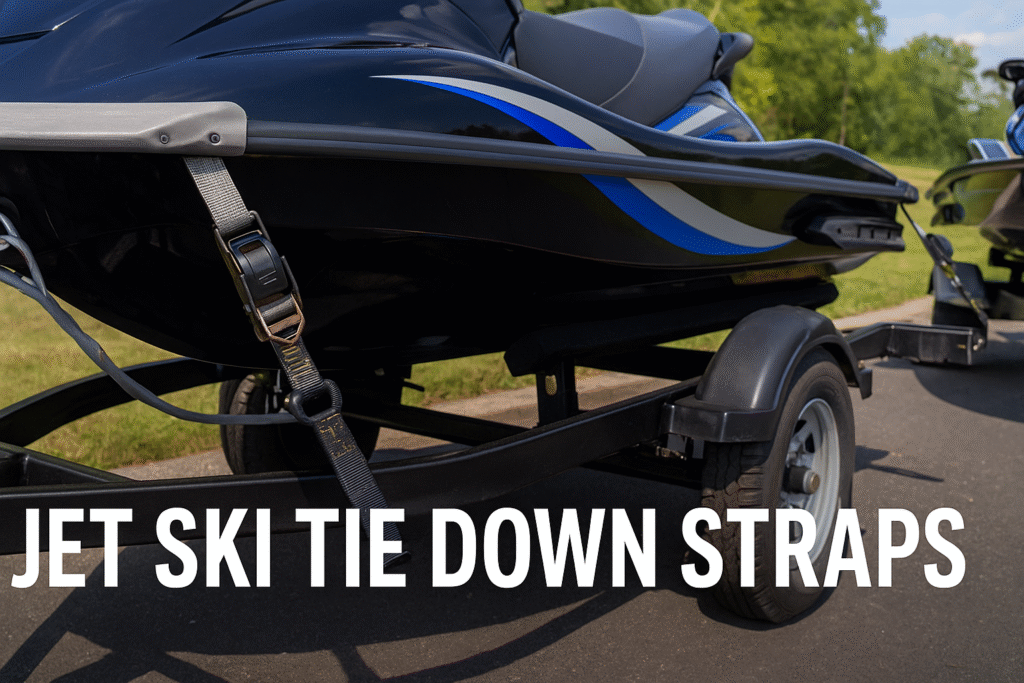Introduction – Why Straps Are the Silent Safety Gear
The sound of a jet ski revving across open water is the essence of summer. Riders dream about long weekends, blue lakes, and freedom on the waves. But behind every perfect day on the water lies an overlooked step: transporting the ski safely to the launch ramp. Many riders underestimate this stage, tossing on whatever straps they find in the garage, assuming the winch line alone will do the job.
The truth is simple: the ride to the ramp is often the most dangerous part of the day. Highways, sudden braking, crosswinds, and potholes apply enormous forces to your trailer and personal watercraft. Without the right jet ski tie down straps, even the smallest oversight can lead to a shifting hull, a damaged gelcoat, or worse—an accident on the road.
This master guide is written to go far beyond “hook and ratchet.” Over the next 4000 words, you’ll gain a deep understanding of strap types, why they matter, how they’re built, and how to turn trailering into a disciplined, safe, and repeatable process. We’ll also cover advanced strategies like seasonal preparation, trailer dynamics, legal responsibilities, and long-term maintenance. By the end, you’ll see tie downs not as an accessory, but as the silent guardians of your freedom on the water.
Chapter 1: The Real Physics of Trailering a Jet Ski
Every time you haul a jet ski, physics becomes your silent passenger. At 60 miles per hour, a 700-pound craft generates forces many times its weight with each bump or sudden stop. Those forces break down into three main categories:
- Vertical bounce: caused by dips, potholes, or uneven road surfaces. This makes the hull rise and slam back onto bunks unless straps press it firmly down.
- Lateral sway: generated by side winds or sharp turns. Without lateral resistance, the ski can lean, shifting weight unevenly and stressing trailer mounts.
- Forward and backward creep: braking and acceleration push the ski against the bow roller or pull it backward from bunks. The winch line alone is not designed to absorb these repeated shocks.
The role of jet ski tie down straps is to distribute these forces safely, anchoring the craft downward and outward so it behaves like an extension of the trailer. Riders who understand this physics recognize that strapping a PWC isn’t a chore—it’s a shield against laws of motion that never take a break.
Chapter 2: Anatomy of a Tie Down Strap
A strap may look like simple webbing with hooks, but its design is a product of engineering. A standard jet ski tie down strap has four key parts:
- Webbing: Almost always made of polyester for its strength, UV resistance, and low stretch. Nylon stretches too much, weakening hold, while cotton degrades quickly.
- Hooks: Usually S-hooks or J-hooks, often rubber-coated or vinyl-dipped to prevent scratching. The best come with spring-loaded latches to prevent accidental unhooking.
- Ratchet or Cam Mechanism: The tightening system. Ratchets provide strong, precise tension. Cam buckles are faster but less secure.
- Housing (for retractables): Protects and rewinds webbing, preventing tangles and reducing UV exposure.
The weakest component defines the strap’s performance. Cheap straps often fail not from snapped webbing but from corroded hooks, bent ratchets, or weak stitching. That’s why marine-grade straps specifically built for jet skis are worth the investment.
Chapter 3: Choosing the Right Strap for Your Ski
When selecting straps, don’t just grab the first set on the shelf. Ask yourself:
- Working Load Limit (WLL): Is the WLL high enough to exceed the ski’s trailering forces? Always choose straps with ratings well above your craft’s weight.
- Breaking Strength: Though less practical than WLL, it shows how much punishment the strap can endure.
- Length & Width: Jet skis often need straps between 2–4 feet in length. A 1-inch polyester webbing is ideal for strength without bulk.
- Salt Resistance: If you launch in saltwater, choose straps with corrosion-resistant coatings.
- Retractable vs. Standard: Retractable straps eliminate loose tails, speeding up every launch.
A pair of retractable jet ski tie down straps may cost more, but the convenience of tidy, tangle-free trailering often pays for itself in fewer headaches and longer strap life.
Chapter 4: Step-by-Step Routine for Strapping a Jet Ski
Trailering should follow a predictable rhythm every time. Here’s a routine you can adopt as habit:
- Bow Security First: Tighten the winch strap so the bow eye rests against the roller. Clip the safety chain as backup.
- Trailer Side Hookup: Attach each strap to the trailer’s low, reinforced anchor points. Lower is better for downward pressure.
- Transom Eye Connection: Clip hooks into the stainless-steel eyes at the rear of the ski. Use soft loops if you want to avoid metal-to-gelcoat contact.
- Tightening Process: Ratchet each strap gradually, alternating sides. Aim for firm tension, not crushing force. The hull should not flex.
- Final Inspection: Check for twists, ensure hooks are fully seated, and lock ratchet handles.
- Short Test Drive: After 200–300 meters, stop and re-check strap tension as webbing settles.
Make this checklist second nature, and you’ll never arrive at the ramp worrying about shifting cargo.
Chapter 5: The Case for Retractable Straps
Retractable straps are more than a convenience—they’re a revolution for PWC owners. Their advantages are worth highlighting:
- Speed: Pull, hook, ratchet. Done. No dealing with leftover tails.
- Clean Deck: Nothing drags, flaps, or tangles around wheels.
- Longevity: Webbing is stored inside the housing, away from UV and weather.
- Safety: Reduced chance of loose strap ends catching on the road.
If you trailer frequently or launch alone, retractable jet ski tie down straps save enormous time and frustration.
Chapter 6: Common Mistakes Riders Make
- Relying Only on Winch Strap: The bow winch isn’t designed to replace stern tie downs.
- Overtightening: Crushing the hull or bending the rub rail weakens your ski.
- Skipping the Safety Chain: Without redundancy, one failure can cause disaster.
- Crossing Straps Poorly: Straps rubbing against the pump housing cause wear.
- Using Non-Marine Straps: Regular cargo straps rust quickly in salt air.
Every mistake has one solution: treat tie downs as safety equipment, not afterthoughts.
Chapter 7: Seasonal Strap Care
- Summer Heat: UV exposure is brutal. Always pick UV-stable polyester straps.
- Fall & Winter: Moisture during storage creates mold. Dry straps completely before packing.
- Spring Checkups: Before the first ride of the season, inspect stitching and hooks for weakness.
Year-round riders often keep two strap sets: one for daily use, another stored as backup.
Chapter 8: The Psychology of Safe Trailering
Why do riders skip steps at the ramp? Usually, it’s impatience. The water is right there, and strapping down feels like wasted minutes. But the safest riders build habits that turn strapping into muscle memory. Over time, the discipline of always securing jet ski tie down straps in the same order pays off—no missed steps, no rushed mistakes, no regrets on the highway.
Chapter 9: The Legal Angle
In many states, law enforcement checks trailers during summer boating season. If your PWC isn’t visibly secured with stern straps and a bow safety connection, you can be fined. Worse, if a ski comes loose and causes damage, you’re fully liable.
The law reinforces what physics already proves: stern straps are not optional. They’re mandatory—by both regulation and common sense.
Chapter 10: Maintenance as a Ritual
Straps don’t last forever. Build these habits into your routine:
- Rinse with fresh water after salt exposure.
- Air-dry before retracting or storing.
- Lubricate ratchets with marine-safe spray (avoid spraying webbing).
- Store away from direct sun when not in use.
- Replace every 3–5 years or at first sign of wear.
Maintained straps never fail unexpectedly. Neglected straps always fail when it matters most.
Chapter 11: Troubleshooting Problems
- Ratchet Stuck: Relieve tension slightly, then fully press the release.
- Strap Won’t Retract: Clean the housing of sand and salt, rinse, and dry.
- Webbing Frayed: Replace immediately. Never patch or tie knots.
- Hooks Bent: Replace straps. Bent hooks compromise safety instantly.
Chapter 12: Real-World Stories
- Weekend Rider: A family skipping stern straps had their ski shift six inches backward on a highway. The winch strap frayed, nearly losing the PWC.
- Saltwater Pro: A rider who rinsed straps after every ocean launch reports 5+ years of use without failure.
- Highway Hauler: Using retractable straps saved one solo rider 15 minutes every trip, turning launch prep into a quick, confident routine.
These stories show how small habits and equipment choices create big differences.
Conclusion – Turning Habit into Confidence
Jet skiing is about freedom, but freedom only comes with preparation. Proper jet ski tie down straps turn trailering from a risk into a routine. They manage physics, protect your hull, comply with laws, and give you peace of mind every mile.
Invest in quality straps. Inspect them like safety gear. Build habits that leave no step forgotten. Over time, you’ll notice the difference: launches become calmer, roads feel safer, and your focus returns to the reason you bought the ski in the first place—pure enjoyment on the water.
Your tie downs may never get attention at the dock, but they’re the reason you arrive there ready to ride. In 2025 and beyond, that’s the real definition of adventure done right.
FAQs
Q: Can I reuse car straps for my jet ski?
Not recommended. They lack UV and corrosion resistance.
Q: Should straps be crossed or straight?
Straight straps usually work best. Cross only if geometry demands it.
Q: How many straps do I need?
Two stern straps plus bow winch strap and safety chain at minimum.
Q: Are retractable straps strong enough?
Yes—when rated properly. They combine convenience with full strength.
Q: How often should I check straps?
Inspect before every trip and re-check after 10 minutes on the road.



